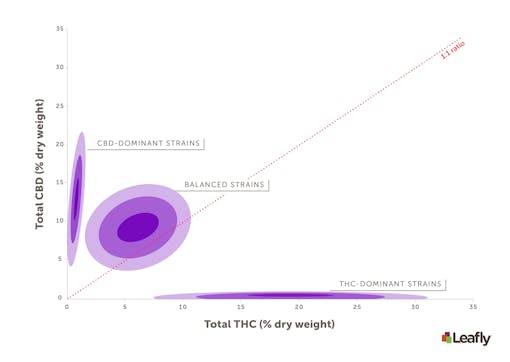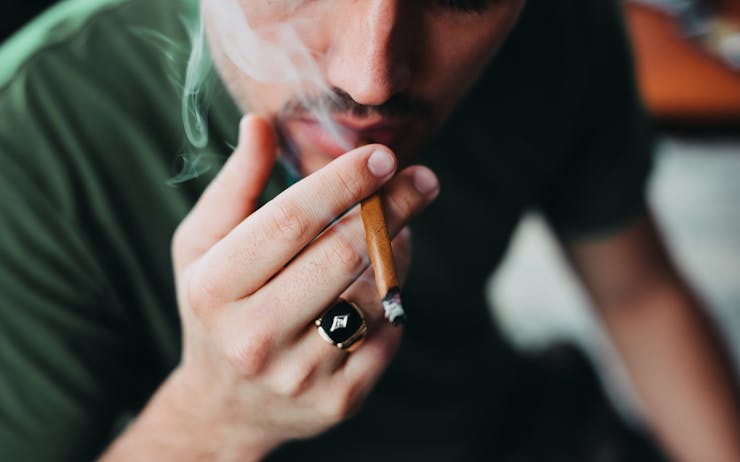Predicting Cannabis Strain Effects From THC and CBD Levels
Whether you’re an adult-use consumer looking for a specific kind of high or a medical patient seeking symptom relief, the THC:CBD ratio will strongly affect your experience. As Leafly has explored previously, CBD is able to diminish some of THC’s effects because it interacts with receptors in the brain very differently than THC does.
The psychoactive effects of cannabis depend on THC’s ability to activate the CB1 receptor. The presence of CBD changes THC’s ability to activate CB1 receptors and laboratory studies in both animals and humans, which tells us that CBD can diminish some of THC’s effects (Figure 1). This is a big reason why a balanced strain like Harlequin or Cannatonic will hit you very differently from THC-dominant strains like Blue Dream, Sour Diesel, or Northern Lights.

Figure 1: The psychoactive effects of cannabis depend largely on THC’s ability to activate CB1 receptors in the brain. Left: Activation of CB1 receptors by THC in the brain triggers many of the classical effects of cannabis. This includes pleasant effects like euphoria and relaxation and side effects like short-term memory impairment and anxiety, especially at higher doses. Right: CBD does not activate the CB1 receptor. Instead, CBD interferes with THC’s ability to activate the CB1 receptor, which can decrease some of THC’s side-effects. (Amy Phung/Leafly)
THC and CBD aren’t the only things that matter. Strain effects will also depend on the presence of other compounds, like terpenes. Nonetheless, the THC:CBD ratio is a huge factor in how a strain will affect you. Can we anticipate any general effects from the THC:CBD ratio alone?
Predicting Likely Strain Effects
It is well established that CBD does not have the psychoactive effects that THC does. When people take pure CBD, even at very high doses, it is well tolerated and produces no obvious intoxicating effects. We also know that when in the presence of CBD, some of THC’s effects are reduced. CBD won’t erase THC’s psychoactive effects, but the effects will be different.
Cannabis connoisseurs will be well aware of the general differences between the effects of THC-dominant vs. balanced strains, and will want to dig deeper into strain information (e.g. terpene levels). Novice cannabis consumers, by contrast, should start by understanding the basic differences between balanced vs. THC-dominant strains before worrying about further subtleties or experimenting with the more potent cannabis products.

Figure 2:Cannabis strains can be grouped into three broad categories based on their THC:CBD ratio. THC-dominant strains have significant THC levels but negligible CBD. Balanced strains contain significant levels of both THC and CBD, but generally less THC than THC-dominant strains. CBD-dominant strains (hemp) contain significant CBD levels and negligible THC. See this article for more information. (Amy Phung/Leafly)
Balanced strains like Harlequin or Cannatonic will still get you high, but your experience will be noticeably different compared to THC-dominant strains. Based on what we know from scientific studies, the effects of balanced strains may differ from THC-dominant strains in the ways listed below.
Important caveat: The differences listed below are based on what we know about THC and CBD from human and animal studies. They’re the ways we can reasonably expect the effects of balanced strains to differ from THC-dominant strains based solely on their THC:CBD ratios. The presence or absence of other compounds will likely influence the effects of specific strains and products. The list below should be viewed as a basic introduction to plausible differences between balanced and THC-dominant strains. It should not be considered a definitive guide to how every single strain will affect you.
You May Be Less Likely to Experience Anxiety With CBD Strains vs. THC-dominant Strains
Studies in both humans and animals indicate that CBD can have anti-anxiety effects. Studies in humans have observed that CBD can diminish the anxiety provoked by a stressful situation (like public speaking) or the paranoia and cognitive impairment provoked by THC administration. Laboratory studies in animals also generally find that CBD reduces behavioral measures of anxiety.
There seem to be two important reasons for this. First, CBD diminishes THC’s ability to activate CB1 receptors, which is critical for many of the core components of the cannabis high. For some people, this includes anxiety or paranoia (especially with high doses of THC). Second, CBD can exert direct anti-anxiety effects through its influence on other receptor systems in the brain. CBD’s ability to activate specific serotonin receptors in the brain seems to be related to some of its anti-anxiety effects. (The serotonin system is a common target of some prescription drugs commonly used to treat anxiety).

Figure 3: CBD interacts with many different receptor systems in the brain. It interacts with cannabinoid receptors indirectly by interfering with THC’s ability to activate them. CBD directly activates many other receptor types in the brain, including opioid, dopamine, and serotonin receptors. Its effects through those receptor systems may allow it to treat a variety of medical ailments. (Amy Phung/Leafly)
You May Experience Less Short-Term Memory Impairment

A hallmark of the THC-induced high, especially at higher doses, is short-term memory impairment. Studies in humans have found that certain memory deficits caused by THC consumption are diminished by CBD. For example, a 2010 study examined the effects of smoked cannabis on memory. Intriguingly, this study assessed regular cannabis consumers and allowed them to ingest their own cannabis. Both cannabis and saliva samples were subsequently used to measure THC and CBD levels.
Participants were split into two groups based on the THC and CBD levels that researchers measured in their samples. Some were smoking what we’re calling THC-dominant strains, which lack significant levels of CBD, while others were smoking balanced THC/CBD strains. On average, the THC content was similar in both groups, but the cannabis consumed by those smoking balanced strains also contained CBD. The result: those who smoked balanced strains did not display the memory impairment seen in the THC-dominant strain consumers.
Another human study examined the effects on memory of oral consumption of pure THC and CBD. Consumption of only THC resulted in memory impairments, as expected. When participants were given CBD prior to THC consumption, some memory deficits were diminished, but not others. Thus, CBD won’t simply block all of THC’s effects. Some may be diminished while some are not. The specific effects will depend on the precise THC:CBD ratio, method of consumption, and presence of other compounds, such as terpenes.
You May Be Less Likely to Get Sleepy, and More Likely to Feel Alert

It is well established that THC can have sedative effects, and small studies in humans have found that CBD can counteract them. Pure THC given on its own tends to have sedative effects, while pure THC and pure CBD given in combination tends to produce increased wakefulness. Animal studies are generally consistent with these findings: administering pure CBD to rats can increase wakefulness and decrease REM sleep.
It’s possible that CBD’s effects on wakefulness depend on dose. Both human and animal studies indicate that pure CBD, given alone or in combination with pure THC, has anti-sedative effects at low-to-moderate doses. Small human studies where people have been given very large doses of pure CBD have been mixed, with some finding sedative effects and others finding no effects on wakefulness.
Consuming a commercial strain should be equivalent to receiving a low dose of CBD, so you may be less likely to experience sedation by consuming a balanced strain that contains both THC and CBD. This is also what we expect based on our knowledge that activating the CB1 receptor promotes sleep. Remember, CBD diminishes THC’s ability to activate CB1 receptors. This is another example where one of THC’s potential side effects (sedation) will likely decrease in the presence of CBD.
Lastly, it’s worth mentioning that it’s still possible that some CBD-containing drugs and high-CBD (hemp) strains have sedative effects. This could be caused by compounds other than CBD, such as the terpene myrcene, which can be present at significant levels in certain strains. So, while knowing the THC:CBD can tell you a lot about the potential effects of different strains, it may not always be a surefire guide to predicting exactly how a strain will affect you.
You May Be Less Likely to Get the Munchies
Hunger has long been one of the most famous side effects of cannabis consumption. For some, it’s a wonderful part of the cannabis experience. For others, it’s a highly undesirable side effect that makes them leery of consumption.
This is another effect driven by THC’s ability to activate CB1 receptors. In laboratory studies in rodents, increased feeding is observed once the rodents are given THC or other compounds that activate CB1 receptors. If you prevent THC from activating these receptors, you do not see increased feeding. That’s how we know that the THC-CB1 receptor interaction is critical for this effect.
Animal studies have also investigated how CBD affects feeding behavior. On its own, CBD seems to have no effect. However, in the presence of compounds that activate CB1 receptors, it blocks the increases in feeding that are observed with CB1 receptor activation alone. To my knowledge, CBD’s effects on hunger have not been studied in humans.
Given what we know about CBD’s ability to interfere with the THC-CB1 receptor interaction, we would expect balanced strains containing CBD to be less likely to give you the munchies, while THC-dominant strains should be more likely to do so. Again, it’s possible that the presence or absence of other compounds will also matter.

Figure 4: Consumers will experience different effects with different products and strains. THC and CBD levels can vary widely between strains, and knowing the THC:CBD ratio can help you anticipate and remember how specific strains affect you. Based on laboratory experiments, some of the classical THC-induced effects of cannabis may be diminished in balanced strains with significant CBD levels. Ultimately, the effects of a strain will also depend on a variety of other factors. (Amy Phung/Leafly)
Conclusion
Whether you’re a seasoned consumer or new to cannabis, it’s worth considering the THC:CBD ratio when assessing what kind of strain is right for you. This is especially true for novice cannabis consumers who may be nervous or overwhelmed by the sheer variety of strains and products.
New consumers may want to start out with balanced strains, which not only have lower THC levels than most THC-dominant strains, but also contain CBD. Everyone’s different, and there are certainly no guarantees, but balanced THC/CBD strains should make you less likely, on average, to experience unwanted side effects like anxiety, sleepiness, or feeling “too high.”





